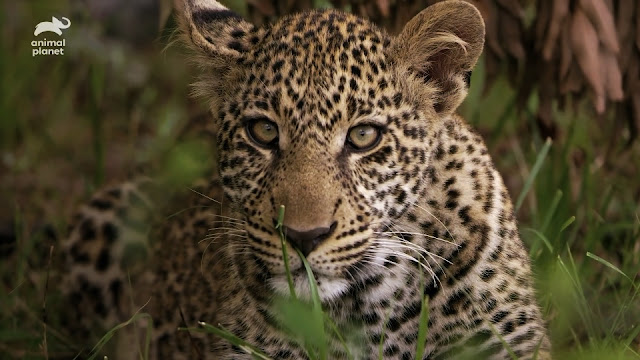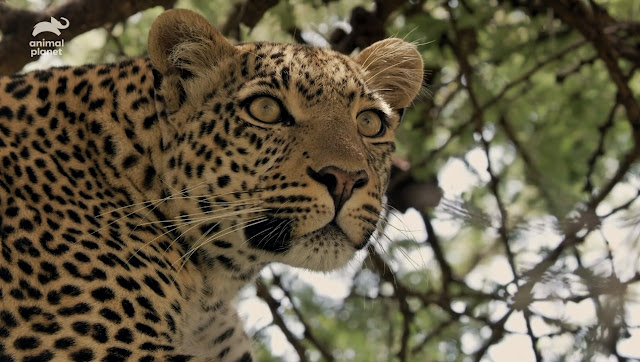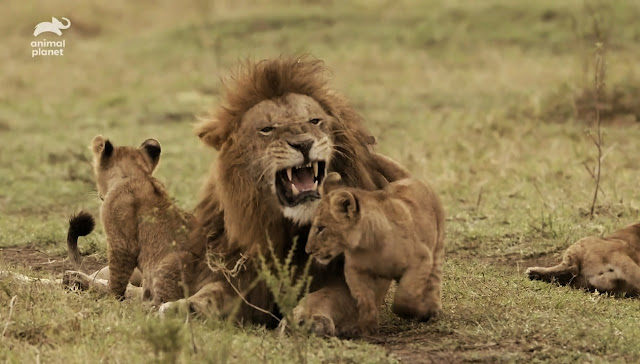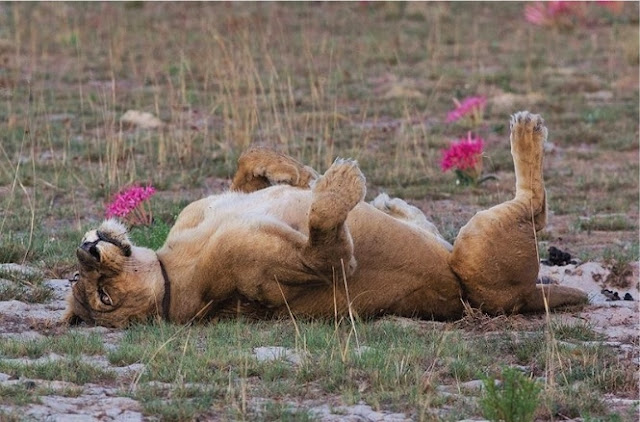Review of The Last Lioness (2009): https://youtu.be/U7LaRZqLb0U
and, The Real Lion Queen (2014): https://youtu.be/87GAGZCbbKE
Disclaimer
The narrative represents itself as a review article of The Last Lioness (2009) and The Real Lion Queen (2014). Used photographs in this article are duly documented, and credit for the photographs goes to their respective owners.
The Queen in her Domain: Lady Liuwa in her territory
Photo Credit: John Hindman
"EVERY ANIMAL, bird and insect has found its grace in the African 'circle of life'. The circle would be complete if it wasn't for one tiny flaw – 'the king is dead.'" — This is how the story begins. Rich vegetation, embellished with vast grazers would seem to be an ideal habitat for lions to thrive, but when the settlers and poachers take out all fellow lions, giving the chance to a robust population of hyenas, surrounded by smattering villages, it suddenly turns out to be a gruesome place to live in. Within Liuwa Plain National Park in Zambia, there are few safe havens for lions for their long drawn naps and resting; and at the end of the day, the notorious clans of hyenas are ever ready to intimidate and snatch away the hard-earned meal. This was the horrifying predicament, faced on a daily basis by Lady Liuwa, the "Last Lioness" of Liuwa Plain. Lady Liuwa was an icon, and a symbol of survival and resilience. Due to years of poaching and illegal trophy hunting, lions were completely eradicated from Liuwa Plain in the 1990s, except for one lioness – Lady Liuwa. Her presence was first confirmed in 2002 and since then she roamed the plains for years as the sole survivor in the park. Yesterday happened to be her fourth death anniversary. How can the wildlife enthusiasts, especially, the big cat lovers, forget the anecdote of Lady Liuwa? On the occasion of World Lion Day, The Wild Tales is feeling privileged to share her story. Let us reveal the pages of her memoir, renovating the story of the extraordinary lioness, coupled up with the strong plot of a successful conservation story — a resurrection of the lion kingdom.

Cameraman Herbert Brauer filming Lady Liuwa
Photo Credit: Animal Planet
Filming in Proximity: Lady standing just a few meters away from Herbert Brauer
Photo Credit: Legend and Legacies
For so many years, Lady Liuwa, the last beacon of an erstwhile massive lion pride, happened to wander the plains alone. The modern-day realities of wilderness caught up the lion prides of Liuwa, including Lady's own pride, and before anything could be done to save the day, Lady became alone – completely on her own amidst the vast habitat of the reserve. Liuwa Plain National Park is an 3,369 sq km (1,301 sq mi) national park in Zambia's Western Province. "Liuwa" means "plain" in the local Lozi language, and the plains originally served as a hunting ground for Lubosi Lewanika, the Litunga (king or paramount chief) of the Lozi people. The area was designated as a protected area by Lubosi Lewanika in the early 1880s, and as a national park in 1972, when Zambia's government took over management. The nonprofit conservation organization African Parks (AP) Conservation has managed Liuwa in partnership with the Department of National Parks and Wildlife and the Barotse Royal Establishment since 2003. In a patch of ground with no family and friends, and with endless adversaries, she battled every day for her survival. Lions and hyenas are born rivals, regularly throwing down in violent clashes of tooth and claw, and the hellish predicament of breakdown. Less powerful than lions, hyenas must win with the upper hand of numbers if they are to steal a kill from a few cornered lions. Without a pride to support her, Lady expended precious energy taking down and defending kills, only to ultimately lose it to hyenas anyway. Here in the African savannah, the real king is one who goes to bed with a full stomach. The odds were not just stacked against her, they were veritably falling on top of her, crushing her to death, but Lady happened to be the true queen with all her singularity despite the unlikeliest atmosphere of survival. She learned not just to survive, but to thrive, reaching the age of seventeen years, proving the ultimate testament of her time. Every scar on her gracious face eventually tells a story of a life hard-earned, where being conniving was not enough, she had to be extremely aware to survive. She learned to hang on the periphery of the bordering villages, conspicuously taking the advantage of the hyenas' tendency to avoid the humans. Neither entering the settlements nor killing their livestock, she was accepted as a benevolent presence by the villagers and herdsmen. It was widely believed that Lady was eventually the reincarnation of the spirit of Mambeti, a beloved daughter of the king's favourite game warden. Every day lady would rest at Mambeti's burial site, solidifying her reminiscence in the villagers' hearts. It was this love and appreciation that protected her.

The new males from Kafue National Park in 2009 (above); three years later in 2012, they had estimated themselves to be the dominant ones (below)
Photo Credit: Animal Planet
With no lions to be found, she looked to humans for companionship. Her extraordinary story of survival, as well as how African Parks helped give her a pride of her own, became one of the most moving wildlife films ever produced. “Lady Liuwa was a truly exceptional lioness, so much so that it is impossible to do justice to her in words,” said Peter Fearnhead, CEO of African Parks Conservation —
Oftentimes she would lie just five meters away from our campfire in the middle of the park. When it came time to go to bed, she would follow, walking parallel to the path and then fall asleep in front of one of our tents. In the mornings, we would find her in a tree, just watching but never threatening us. After years of being solitary, and after several reintroductions and careful management, we were finally able to unite her with her own kind. While her passing saddens us all, she leaves behind a legacy of survival in the small but growing pride in Liuwa Plain.
African Parks (AP) Conservation – the undertaking team of the rehabilitation project
Photo Credit: Animal Planet
Ace wildlife cinematographer, Herbert Brauer, had spent years in the presence of Lady Liuwa, and had always been cherishing a dream of a pride in Liuwa in his mind. With the ecosystem incomplete, African Parks decided to reintroduce lions to the park, as a part of their environmental management plan to restore the welfare of the region. After over half a decade of lonely wandering and calling into the unanswering abyss, Lady was finally going to have some companionship and much-desired backups. Lions are social felines, relying on the bondage of pride mates and depending upon their solidarity in the hard times of survival. Even the solitary males too interweave their time alone with a pride or another wandering nomad, seeking for his luck. Finally, Lady would be reunited with her own kind. When she would be calling out across the plains, her call would, at last, be responded to; when she would be lifting her head to the breeze, there would be the scent of another lion to meet her sensation.

Lady Liuwa inside her boma
Photo Credit: Animal Planet
The efforts to find Lady Liuwa her own family were not without setbacks. After five years of waiting for lions to return to Liuwa from the larger landscape, and after securing the park through improved law enforcement and working with local communities, African Parks reintroduced a male lion in 2008 to join Lady. Sadly, he died during the translocation process. In 2009, a year after a failed initiative, the Zambian Carnivore Program (ZCP) and African Parks (AP) collaborated to transfer two young adult males of nearly three-year-old from nearby Kafue National Park. It was hoped that they would eventually win the affections of Lady, and produce the next generation. Three years after this translocation operation, the filming crew came back, hoping to catch up with their known lions with the first flicker of new arrivals. Sadly, no cubs were resulted from the copulations attempted. Evidence said that Lady was getting gradually old, and becoming unable to conceive, but Innocent Tembo, King Lewanika head guide, believed that it was not age or infertility that was rendering fruitless results. "She's the queen of the plains," he emphasised, "She wasn't interested in these boys from the east. They weren't worthy, so nothing came of it," he mused over in an afternoon coffee break of the crew in the bush.

Lady Liuwa checking out the boundary of boma of the young females
Photo Credit: Animal Planet
After stumbling endeavours to re-estimate a pride in Liuwa, African Parks Conservation, a conservation NGO that manages national parks and protected areas across Africa (and has been managing Liuwa Plain in partnership with the Zambia Department of National Parks and Wildlife (DNPW) and the Barotse Royal Establishment since 2003), made the risky decision to reintroduce females that could mate with the existing duo of the males. The team did not risk bringing forth adult lionesses since dominated by their vitality and spirit, they could hard Lady. This is how in 2011, two twenty-month-old adolescents – Sepiwa, a brown-collared lioness, whose name means 'hope' in the local dialect, came to live with Lady, with her white-collared sister Sepo, meaning 'short' from Angola National Reserve in the west to Liuwa Plain National Park. Inexperienced and now exposed to an unfamiliar territory, these sisters were more vulnerable than ever before. It was not sure how the males would react in their presence. Lady, however, had already estimated her supremacy. Now, though the power of balance seemed to be shifted, she was still in charge. The young females were safely kept in an enclosure so that any confrontation with the males might be reduced. Lady kept her vigilance. Eventually, the gate of their enclosure was opened and they were set free. A new chapter began. But, this happened to be an initiation with harsh nightmares. No sooner than the newcomers managed to grab a kill, hyenas surrounded them. Two adolescent females were nothing in front of a clan of more than twenty bone crushers. Their sounds, grunts and snarls had attracted the attention of far more dangerous adversaries. For the first time, Sepiwa and Sepo were exposed before the adult males. This time, Lady was not around the corner to protect them as a shield. Sepiwa managed to avoid the seeming danger, while Sepo was caught between the males. They immediately charged and ensured their dominance. Sepo's assertiveness only could save her day from those massive rulers. At the right moment, she crouched in submission. The males moved away. Soon after the incident in 2012, Sepiwa went missing. Her collar stopped giving signals, making the indicating point into a stagnant position. A nasty discovery was made when her collar was found in a marshland, segregated from her decomposed body. It was assumed that she probably caught the hold of livestock, and had to pay the price at the cost of her life. One of the first shocks that the re-establishing project suffered. Furthermore, after a few weeks, Sepo, fled towards the Angolan boundary. In a dramatic rescue mission, Sepo was darted, flown back to the park by helicopter and placed in a boma for safety along with Lady Liuwa to encourage Sepo to bond with Lady, critical for the young lioness' survival. And this time it worked. After two months, they were released back into the park, and were inseparable from that point forward. One of those males were collared, assuming the chance that they would never depart. The growing pride suffered another setback when the two males left the park and entered Angola. The experts started a countdown for the males to return, but to add on yet another massive blow, only one of the males, the collared one, had returned to Liuwa. His ally was shot and killed by villagers, but the other, the collared one, made it safely back to Liuwa on his own, where he became the resident male.

Sepiwa and Sepo, surrounded by hyenas
Photo Credit: Animal Planet
Over the years, a special bonding developed between Lady and Sepo. Brauer was expecting a tight chemistry between the three remaining survivors of the endeavour. The male frequently copulated with Sepo, but every moment after the chance of her conception, there was the fear of Lady's exile from the trinity. Luckily, no such uncanny affair happened. At one point, having the male on her side, Lady lied down by Sepo. This is what a pride looks like. Herbert Brauer's eyes met that of Lady's, as if they were asking: "Is this what you wanted so far?" In 2014, his and his fellow experts' dream came true. Sepo gave birth to her first litter of cubs — two females and a male. Now aged fourteen, Lady was entering that age zone which a handful of lions eventually gets to see. Still strong enough, but no longer hunting as well as she once did, Lady relied on Sepo to do most of the hunting for the pride. Instead, Lady kept her place at the head as the honoured grandmother – the matriarch of the pride with her years of wisdom and experience, and babysitting the cubs while Sepo was busy in taking down dinner. Andrew, a photographer who spent a month in the park, captures one beautiful event:
It was sunset and Lady was all alone. We follower her as she slowly rose and began a call and response with Sepo, Lady adjusting her path each echoing back from the dark. Eventually, we picked up Sepo and the cubs with our spotlight, but Lady still hadn't noticed them. They were crouched in the long grass, and when Lady was a few metres away, they sprung up, startling Lady who jumped backwards before realising who it was. She immediately rushed forward, nuzzling Sepo and the cubs who were just jumping on top of her. There was so much love at that moment.
Lady Liuwa rolling on her back
Photo Credit: Legends and Legacies
And, not only the mutuality of reciprocation, a few more remarkable spectacles showed how lofty a resurrection everyone was witnessing, a rebirth of lion population with its divine ambrosia:
Once when Lady was recovering from an injury, and unable to move with the pride, Sepo hid her cubs away, travelled 40 km north to Lady, killed a wildebeest and dragged it over to her, all before travelling 40 km back. That was the kind of love and respect that Lady's pride had for her. She was a very special lion.
Reminisced Innocent Tembo about his time with Her Majesty. So, what was next to expect from such a reputed lion dynasty? A hearty congratulations to the solidarity and strength of the pride. Sepo's cubs are now stunning adults. She even embraced her second litter of cubs — two males, who were born in November 2016. Around the same time, African Parks in collaboration with the Zambia Carnivore Programme (ZCP), DNPW and Mushingashi Conservancy decided to reintroduce another male lion in September 2016 to help grow the pride and increase genetic integrity. He had a bit rough entry after an explosive encounter with Sepo, but he was reported to be gradually familiarising himself with the pride, and expected him to be yet another strong pillar of the dynasty of the lions of Liuwa. The newly translocated male and the resident male were placed in a boma for two months to undergo the bonding process and they were successfully released into the park to join with the females. While the males were in the enclosure, Lady Liuwa and Sepo would visit them, sleeping just outside of it at night, and staying just a short distance from it during the day. On 15 November 2016, it was confirmed that Sepo had produced another two new cubs, sired by the resident male. While Lady Liuwa could not have cubs of her own, she was seen helping to raise Sepo’s numerous litters over the years, and it was clear that finally, Lady Liuwa had a pride of her own.

Lady from her lofty castle
Photo Credit: Animal Planet
Sadly, the pioneer of the dynasty had to bid adieu her plains after seventeen years of ruling her domain. Lady Liuwa passed away on the 9th of August in 2017. Lady Liuwa’s exact age was unknown, but it is believed she happened to be seventeen-year-old, an extraordinary feat for a wild lion hunting and surviving on her own, and is a testament to the collaborative protection she was afforded by African Parks, the DNPW, ZCP and the BRE. Her remains along with her VHF collar were found a few days latef. There was no sign of human activities. It was not known what she died of, but all signs pointed to natural death. The last time Innocent Tembo saw her in late June she was still strong, but in that last brink of twilight, even the tiniest deviation may cause a lion to fade away. "I was very, very sad to hear that she had passed away. Her story is so touching and so important to Liuwa Plain. What a special lion!" — Innocent expressed, downcasting his eyes, hinting at the pain and vacancy he felt at her passing. But, Lady Liuwa cannot be gone. Her spirit still roams the plains. Overlooking for that "bigger savannah upstairs", Lady blesses her lineage and the lofty denizens of the plains. The Queen is no more, but her immortal soul touches our hearts with her saga of survival — a success story of conservation, a meaningful rendering of the rebirth of the lions in the plains! “It’s incredibly rare for a lion to live to such an old age and to die from natural causes,” said Matthew Becker, CEO of ZCP. "Lions are incredibly threatened across their range given the levels of poaching, conflict killing and habitat loss and fragmentation that is occurring across the continent. Her survival and that of her growing pride signify what can happen when people come together to help protect and restore a species – Lady’s story is one of hope and possibility."

Lady along with Sepo the young female and the resident male, promising the first flicker of forming up a pride in Liuwa
Photo Credit: Animal Planet
Acknowledgements
Will Burrard Lucas
Legends and Legacies
Credits
The Last Lioness (2009)
Narrated by
Hermione Gulliford
Executive Producer
Peter Lamberti
Producer/Writer
Bronwyn Watkins
Editor
Elemien Fourie
Cinematographers
Herbert Brauer
Fergus Clark
Riaan Venter
Original Music
Benjamin Willem
Assistant Cameraman
Tyson Langa
Darren Williams
Additional Camerawork
Peter Lamberti
James Boon
Nathan Pilcher
Online Editor
Danielle Dreyer
Audio Post Production
Martin Ferreira
Ron and Val Nel
Anna Pankova
Assistant Editor
Jamie Forbes
Production Manager
Simone Carr
Production Executives
Hanka Sonnekus
Maria Valente
Consultants
Craig Reid
Petri Viljoen
Development
Venessa Lucas
Nicole Annear
Billi-Jean Parker
Special Thanks
Robin Pope Safaris
Mukambi Safari Lodge
Zambian Wildlife Authority
Barotse Royal Establishment
For National Geographic Channel
Executive Producer
Ashley Hoppin
Executive Vice President of Content
Sydney Suissa
Produced by Aquavision TV Productions for National Geographic Channel
Copyright 2009 — © Aquavision TV Productions
All Rights Reserved.
.......
The Real Lion Queen (2014)
Narrated by
Chris Cook
Produced by Aquavision TV Productions in Association with Smithsonian Networks
Series Producer
Jan Lampen
Editors
Este Nortje (S.A.G.E.)
Writer
Jan Lampen
Researcher
Yurika Kotzé
Camera
Herbert Brauer
Nathan Pilcher
Camera Assistant
Carl Ruysenaar
Eric Willis
Scout
Jacob Tembo
Music
Ben Willem
Graphics
George Webster
Foleys
Frameline
Post Production Services
Aquavision TV Productions
Post Production Supervisor
Martin Ferreira
Online Editor and Colourist
Ian Dormer
Audio Final Mix
Martin Ferreira
Jeanette Simpson
Librarian
Christo Ras
Stock Footage and Stills
Aquavision TV Productions
Special Thanks
African Parks
Zambia Wildlife Services
Republic of South Africa
Produced with the assistance of the Department of Trade and Industry South Africa
For Aquavision TV Productions
Production Manager
Christie Wooding
Head Production Management
Sean O'Neill
General Manager
David Keet

















































